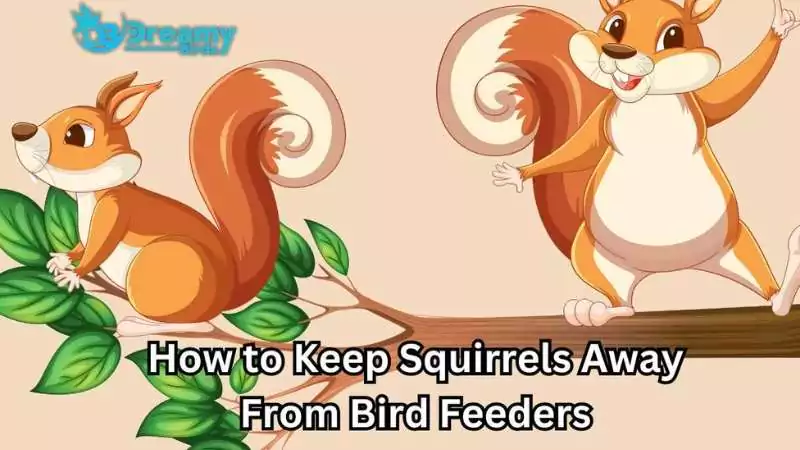Did you know a single squirrel can devour ten times its body weight in bird seed in just one week? That’s like one person eating 1,500 hamburgers! Frustrating, right?
If you’re tired of these furry little acrobats turning your bird feeder into their diner, you’re not alone. So, how to keep squirrels away from bird feeders? In this blog, we’ll dive into easy and effective strategies to save your bird seed for the birds.
Expect tips on squirrel-proof feeder designs, strategic placement, and more to enjoy a squirrel-free birdwatching experience.
Understanding Squirrel Behavior
What makes your bird feeder the ultimate target for those agile, furry creatures? Squirrels, by nature, are opportunistic feeders. Brimming with seeds, your bird feeder is like a treasure trove for them – an irresistible buffet that’s hard to pass up.
But it’s not just the allure of food that makes your feeder so appealing; it’s their remarkable physical capabilities. Squirrels are phenomenal jumpers, capable of leaping up to 10 feet horizontally, and their climbing skills are second to none.
This combination of agility and appetite means that most bird feeders, regardless of location, are within reach of these persistent critters.
Understanding these key aspects of squirrel behavior is the first step in devising effective strategies to safeguard your bird feeders from their relentless pursuits.
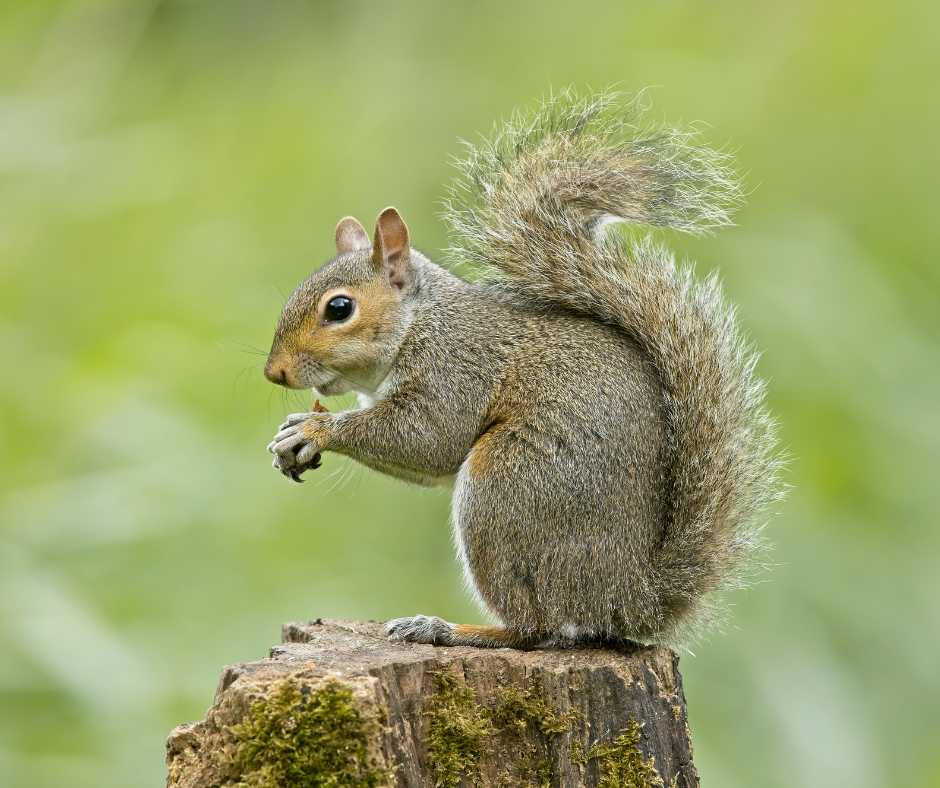
10 Tips on How to Keep Squirrels Away from Bird Feeders
To keep squirrels away from bird feeders, follow these steps:
- Use weight-sensitive squirrel-proof feeders.
- Position feeders 5 feet high, 10 feet from trees/structures.
- Choose squirrel-resistant seeds like safflower or Nyjer.
- Install baffles on feeder poles.
- Regularly clean up fallen seeds/hulls.
- Provide separate squirrel feeding stations.
- Apply cayenne pepper as a natural deterrent.
- Avoid traps or poisons.
- Continuously adapt anti-squirrel strategies.
- Strategically place feeders away from squirrel access points.
Now, let’s delve into these tips in more detail.
Tip 1: Squirrel-Proof Feeder Designs – Selecting the Right Feeder
In the quest to outwit squirrels and secure your bird feeders, choosing the right design that combines efficiency with bird-friendliness is essential. Let’s dive into a comparison of popular squirrel-proof feeder designs to help you make an informed decision:
| Feeder Design | Mechanism | Pros | Cons |
| Weight-sensitive | Closes under squirrel’s weight | Highly effective; selective feeding | May require calibration |
| Wire mesh | Small birds can enter | Durable; excludes larger birds/squirrels | Limited seed types; may deter larger birds |
| Baffle-equipped | Physical barrier | Versatile; can be added to existing feeders | Installation effort; aesthetic impact |
Selecting a suitable feeder is crucial in deterring squirrels. Weight-sensitive feeders are highly effective but may need tuning. Wire mesh models are tough and secure, yet might restrict seed choices and prevent some birds.
Baffle-equipped feeders offer adaptability to your setup, requiring some setup and possibly affecting garden aesthetics. The Brome Squirrel Buster shines with its sturdy design, effectively thwarting squirrels.
Consider each option’s squirrel resistance, appeal to birds, and the maintenance involved in your decision.
Tip 2: High and Mighty – Placing Your Feeder Out of Jumping Reach
When it comes to deterring squirrels from your bird feeders, think vertically. These agile animals are master jumpers, capable of leaping impressive distances vertically and horizontally. This natural athleticism means that the positioning of your bird feeder is crucial in keeping it squirrel-free.
To outsmart these persistent critters, your feeder should be a minimum of 5 feet off the ground. But height alone isn’t enough; also ensure that the feeder is at least 10 feet away from any structures or objects, like trees, walls, or fences, that squirrels could use as a springboard.
Creating this buffer zone effectively turns your bird feeder into an island that’s difficult for squirrels to infiltrate. Consider utilizing a specialized pole system, such as the Squirrel Stopper Pole, which offers not just the ideal height but adds an additional level of challenge for any squirrel attempting to scale it.
This pole can act as a formidable obstacle, making it even more challenging for squirrels to access the feeder. The pole’s design can complement your garden aesthetics while keeping your birdseed safe and reserved exclusively for your feathered friends.
Combining strategic height with clever positioning creates an environment where birds can feed in peace, free from the acrobatic antics of squirrels.
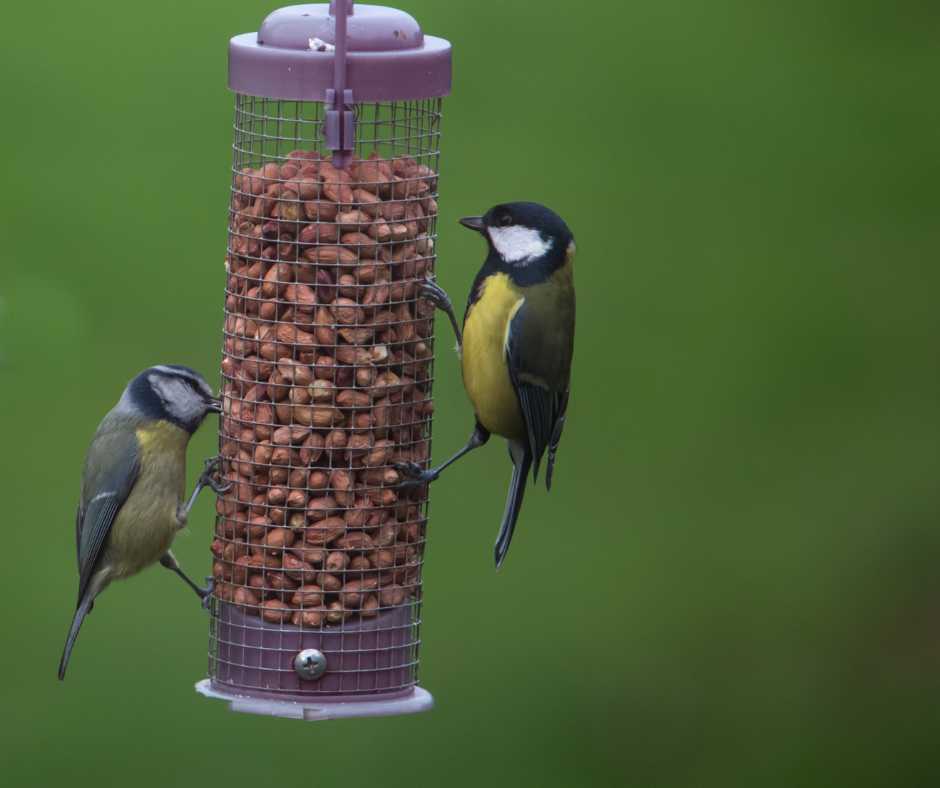
Tip 3: Strategic Separation – Keeping Feeders Away from Trees
Strategic placement is crucial in the journey to safeguard your bird feeders from nimble squirrels. Understanding squirrels’ acrobatic tendencies highlights the importance of mindful feeder positioning to prevent their access. Implement these strategic practices to enhance your feeder’s defense:
- Elevate feeders: Keep feeders at least 5 feet above ground to deter squirrel jumps.
- Distance from trees: Ensure feeders are positioned a minimum of 10 feet from trees or structures, reducing launch points for squirrels.
- Use pole systems: A Squirrel Stopper Pole can add an extra challenge for squirrels trying to reach the feeder.
- Visibility: Place feeders in spots that allow you to enjoy birdwatching without unintentionally making it easier for squirrels to access.
Incorporating these tactics hampers squirrel efforts and enriches your birdwatching experience. A freestanding feeder pole, for example, limits squirrel access and complements your garden’s aesthetics, offering clear views of feathered visitors.
Moreover, thoughtful landscaping around the feeding area—like adding water features or specific plants—can further entice birds while keeping squirrels at bay. Delving into resources like Audubon‘s recommendations can spark additional innovative ideas for feeder placement and garden landscaping that effectively deter squirrels.
Tip 4: Selective Feeding – Choosing Squirrel-Resistant Bird Seeds
In the world of bird feeding, the type of seed you offer can be a decisive factor in managing squirrel visits. Squirrels, like any other creature, have their taste preferences.
Leveraging this, you can select seeds that are less enticing to them but still delightful for birds. Safflower, Nyjer, and white proso millet typically fall under this category. These seeds are less appealing to squirrels, making them less likely to raid your feeders.
Consider mixing these less attractive seeds with your regular birdseed to keep your feathered visitors happy and interested. This not only maintains a diverse buffet for various bird species but also helps in keeping squirrels away. Alternatively, using these seeds exclusively in specific feeders can create a designated ‘squirrel-resistant’ zone in your bird feeding area.
For those keen on enhancing their bird-feeding strategies, the Cornell Lab of Ornithology offers a treasure trove of information on bird feeding and seed selection. Their resources can guide you in choosing the right mix of seeds that cater to a wide range of birds while minimizing squirrel interference.
By being selective with your seed choices, you balance feeding the birds and deterring the squirrels.
Tip 5: Baffle Them with Science – Adding Baffles to Your Feeder
Turn the tide in your favor in the ongoing squirrel war by employing baffles. These clever devices are designed to create an insurmountable barrier for squirrels trying to access your bird feeders. Available in dome-shaped or cylindrical forms, baffles effectively block squirrels from climbing up to or jumping down onto the feeder.
When installing baffles, the key is in their placement. For hanging feeders, affix the baffle above the feeder so that squirrels can’t escape onto it. Place the baffle below for feeders mounted on poles, ensuring it’s high enough off the ground (at least 5 feet is recommended) to prevent squirrels from jumping over it.
It’s also important to consider the baffle size of your feeder and the types of squirrels in your area. A larger baffle might be necessary if you have particularly large or resourceful squirrels. Exploring options at stores like Wild Birds Unlimited for an array of baffle types and sizes can provide a suitable match for your specific bird-feeding setup.
Properly installing and positioning these baffles can significantly enhance their effectiveness, keeping your bird seed safe for its feathered patrons.
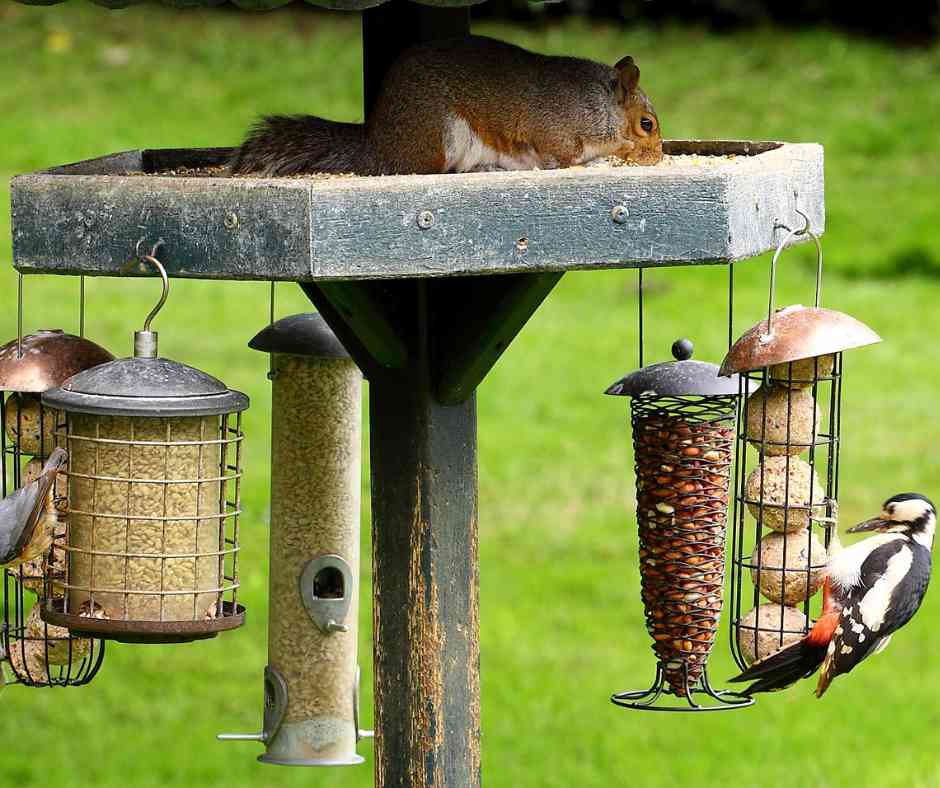
picture collected from – wikimedia
Tip 6: Cleanliness is Key – Keeping the Feeder Area Tidy
Maintaining cleanliness around your bird feeders is more than just a matter of neatness; it’s a strategic approach to deterring squirrels.
When seeds and hulls accumulate on the ground, they become an easy and inviting target for these opportunistic feeders. Regularly clearing away these remnants effectively reduces the area’s attractiveness to squirrels.
A tidy feeding environment is essential in making your bird feeding station less appealing to squirrels. This means routinely checking underneath and around the feeder. Sweep up or vacuum the fallen seeds and hulls. Consider using a seed catcher tray beneath your feeders to minimize spillage.
Implementing a regular cleaning schedule can significantly diminish the likelihood of squirrels frequenting the area for ground pickings. This practice helps in squirrel-proofing your feeding station and promotes a healthier environment for the birds by reducing the risk of mold and disease.
For more detailed guidance on feeder maintenance and creating a clean, healthy environment for your backyard birds, resources provided by the National Wildlife Federation offer valuable tips and best practices. Their expertise can help you keep your feeding area both clean and inviting to the birds while less so for the squirrels.
Read more: How to Clean Bird Feeder
Tip 7: Diplomatic Solutions – Feeding Squirrels Separately
In the delicate balance of backyard diplomacy, offering a separate peace treaty to squirrels might be your masterstroke. You can effectively divert their attention from your bird feeders by setting up a designated feeding station for these furry visitors.
Offering them their favorites like corn, nuts, or specially formulated squirrel food keeps them satisfied and busy away from the bird’s domain.
This approach has benefits, creating a win-win scenario where birds can feast in peace and squirrels are content with their stash. However, it’s important to weigh this strategy’s potential drawbacks.
For instance, while it may reduce squirrel visits to your bird feeders, it could also attract more squirrels to your yard over time. Additionally, ensuring the squirrel feeding area is placed sufficiently far from the bird feeders is crucial to prevent crossover.
Implementing this method thoughtfully can lead to a more harmonious backyard ecosystem where both birds and squirrels coexist without infringing on each other’s space.
For insights into fostering a wildlife-friendly garden and more about living peacefully with backyard critters, visiting The Humane Society’s website can provide valuable guidance and tips.
Tip 8: Natural and Manufactured Deterrents – What Squirrels Dislike
In our arsenal against squirrels, we have several deterrents, each with unique application methods and considerations. Here’s a quick guide to help you choose the best approach for your garden:
| Deterrent Type | Application Method | Effectiveness | Considerations |
| Cayenne Pepper | Sprinkle on seeds/around feeder | High | Reapply after rain; safe for birds |
| Commercial Repellents | Spray or place around feeder | Variable | Product-dependent; choose wildlife-friendly options |
| Decoy Feeders | Set up separate from bird feeders | Can be effective | Requires additional food source |
Cayenne pepper is a powerful, natural squirrel deterrent; a simple sprinkle around feeders deters squirrels but doesn’t affect birds.
Commercial repellents are available for convenience, but effectiveness varies—choose wildlife-safe options.
DIY enthusiasts can also make their repellents using household spices, with sites like The Spruce offering many recipes.
Whether homemade or purchased, these deterrents are key to a squirrel-free bird feeding zone.
Tip 9: The Ethics of Wildlife Interaction – Avoiding Harmful Methods
The ethical treatment of all wildlife, including squirrels, is paramount in managing backyard visitors. It’s vital to avoid methods that could cause harm, such as sticky substances, traps, or poisons.
These approaches pose a risk to squirrels and can inadvertently affect other animals. The objective should always be to deter, not to harm. Adopting ethical practices in wildlife management contributes to the balance and health of our ecosystem.
For guidance on humane and practical strategies, organizations like The Wildlife Society offer a wealth of information, underscoring the importance of kindness and responsibility in our interactions with nature.
Tip 10: Continuous Adaptation – Staying Ahead of Squirrel Antics
The ingenuity of squirrels in their quest for food can never be underestimated, making embracing a strategy of continuous adaptation crucial. As these clever creatures adjust and refine their methods for accessing your bird feeders, your deterrent strategies must evolve in response.
Regularly observing the effectiveness of your current methods and being open to experimentation is key to maintaining the upper hand. Note the successful tactics and those that fall short, and be ready to implement changes.
This dynamic approach ensures you’re always a step ahead in the ongoing dance with squirrel antics, leading to long-term success in keeping your bird feeders for the birds.
You may also read: How to Keep Raccoons Away from Bird Feeders
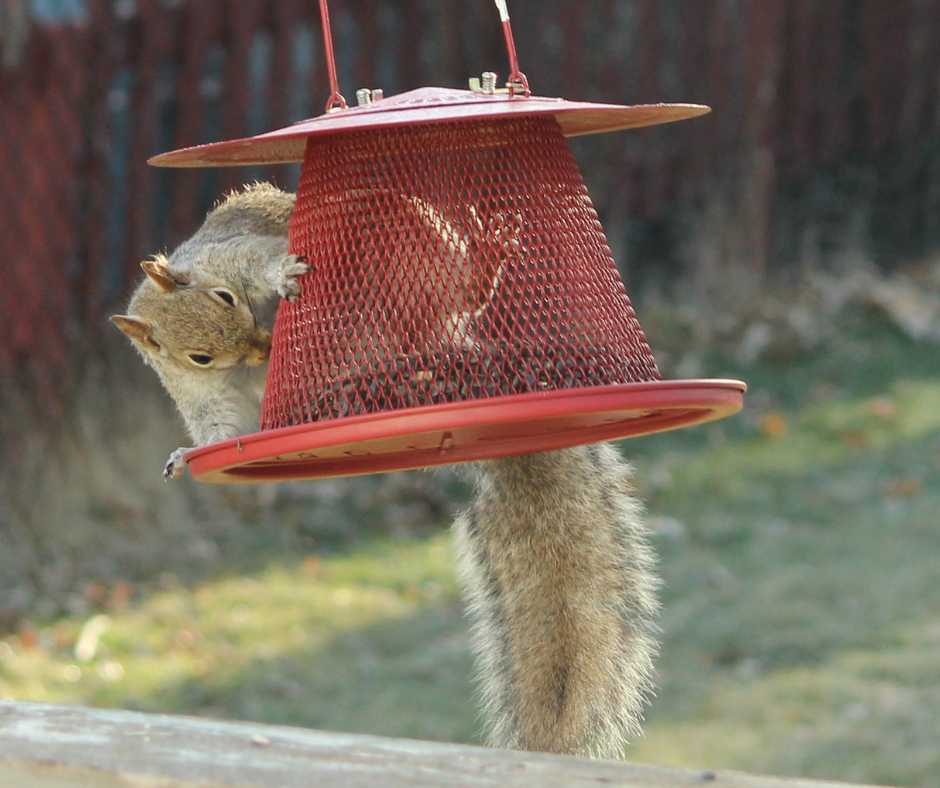
People Also Asked
Can I make my existing bird feeder squirrel-proof?
Absolutely! Adding a baffle or adjusting the placement can enhance your feeder’s squirrel resistance. It’s about outsmarting them, not outspending them.
How effective are spicy deterrents for squirrels?
Spicy deterrents like cayenne pepper can be quite effective. Squirrels dislike the taste, while birds are unaffected. However, remember to reapply after rain or heavy dew.
What should I do if a squirrel still gets to my feeder?
If a squirrel outsmarts one strategy, try another. Consider combining methods, like changing the feeder’s location and adding a baffle. Sometimes, a multi-faceted approach is needed.
Is it a good idea to feed squirrels separately all year round?
Feeding squirrels separately can be a year-round strategy, but monitor it. You should adjust your approach if it leads to an insufficient squirrel population.
Wrap Up
Navigating the intricate dance of managing squirrel visits to your bird feeders tests your strategy, patience, and creativity. While the task might appear formidable, employing the appropriate tactics can revolutionize your backyard into a vibrant bird haven buzzing with life and activity.
This journey isn’t solely about keeping squirrels at bay; it’s about cultivating a space where all wildlife can flourish harmoniously. Embracing practices that honor and protect the natural environment is pivotal in creating a balanced ecosystem within your garden.
Such an approach mitigates conflicts between squirrels and birds and enhances the overall health and diversity of your local wildlife community.
By thoughtfully integrating these strategies, you contribute to a sustainable coexistence, enriching your experience of nature’s wonders.
The ultimate reward is a backyard that serves as a sanctuary for you and a host of wildlife, inviting you to immerse yourself in the tranquil beauty of nature and the delightful company of its varied residents.

